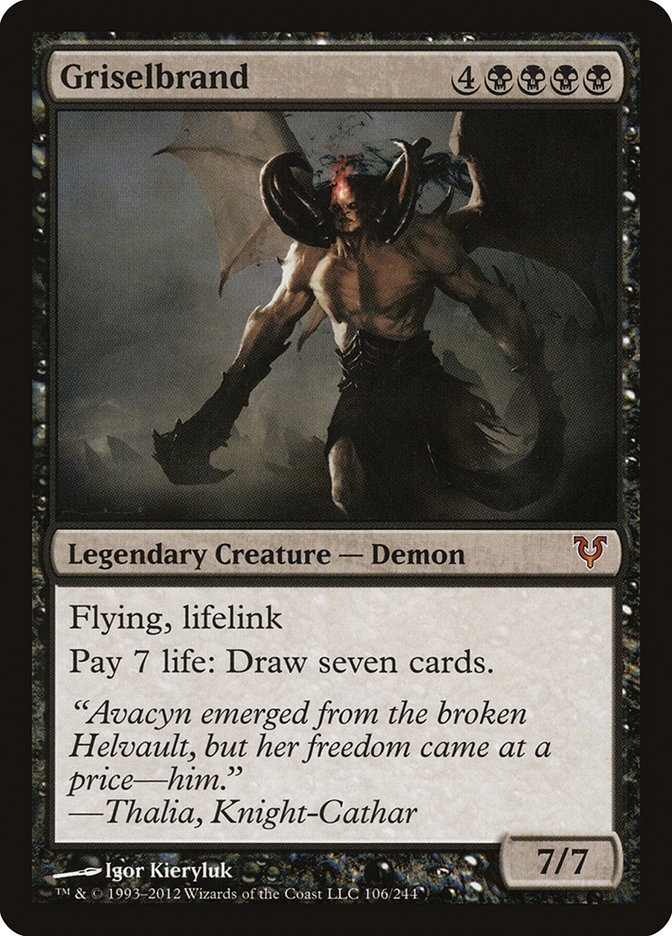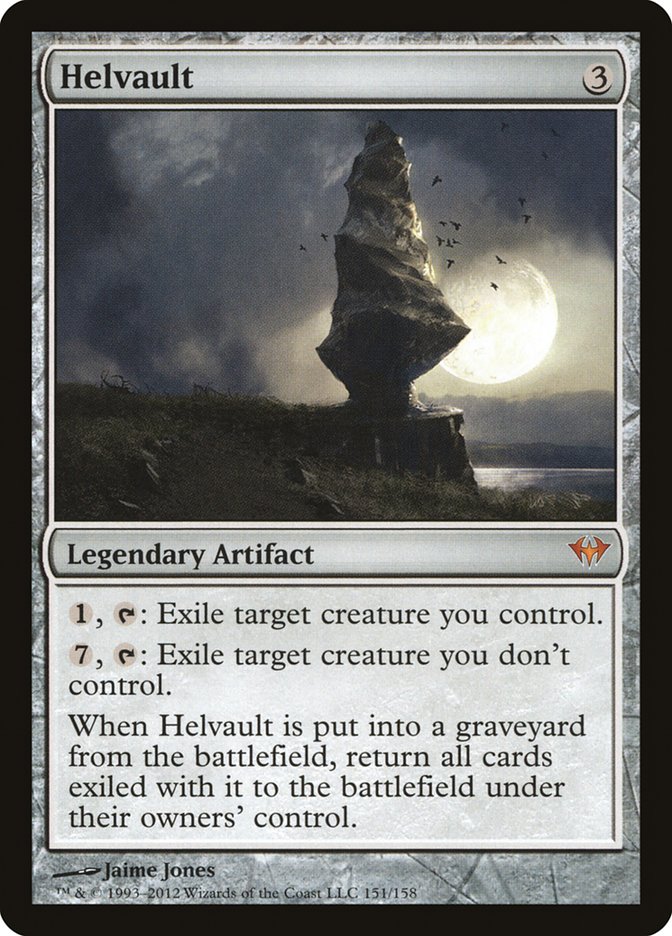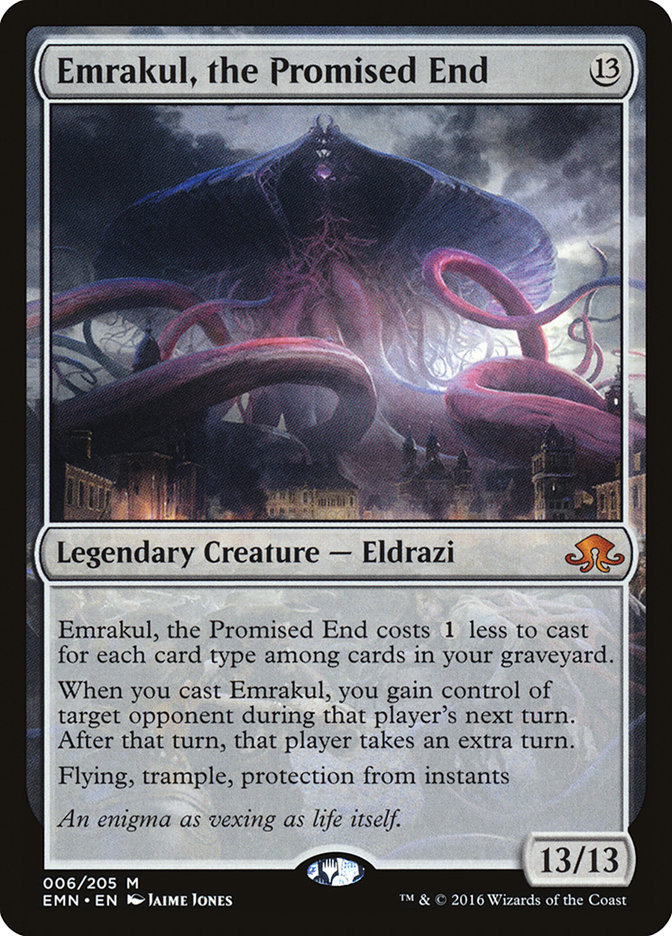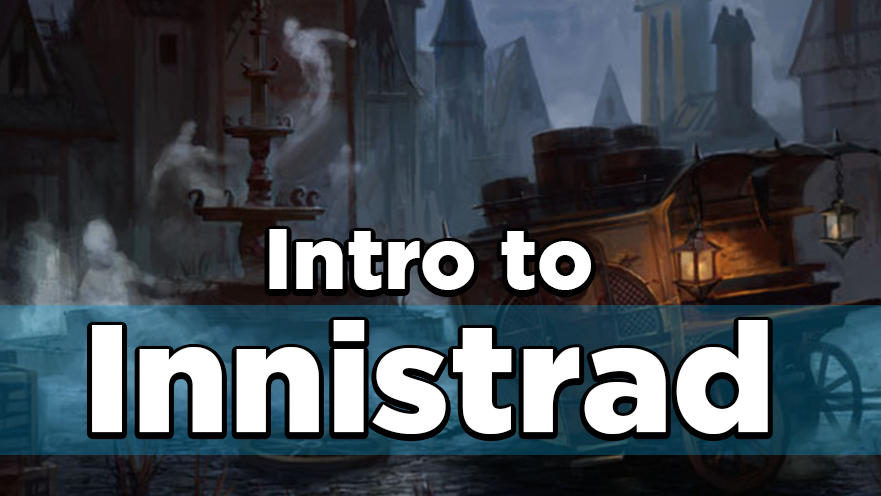With Halloween on the horizon, let’s pay a visit to Magic‘s spookiest plane, Innistrad. The setting for the five sets in the Innistrad and Shadows Over Innistrad blocks, Innistrad is beloved for its gothic horror atmosphere, tribal themes, and flavorful mechanics.
Creatures and Characters

Innistrad is known for its ally-colored tribes, and a number of memorable characters associated with those tribes.
- White-Blue: Spirits, including the Geist of Saint Traft.
- Blue-Black: Zombies, featuring the Frankenstein-like mad scientist Ludevic, “ghoulcaller” siblings Gisa and Geralf, and planeswalking necromancer Liliana Vess.
- Black-Red: Innistrad’s four aristocratic vampire families, led by Olivia Voldaren, Runo Stromkirk, Anje Falkenrath, and local-born Planeswalker Sorin Markov.
- Red-Green: Werewolves, such as the Planeswalker Arlinn Kord and pack leader Ulrich.
- Green-White: Humans, including the Church of Avacyn, which protects Innistrad’s humans from all the other factions. Notable members of the Church include Thalia and Odric.
Humans also play an interesting role in the mechanics of original Innistrad block. The second set, Dark Ascension, had fewer human and human-related cards than in any other, since humans played the role of helpless victims. In contrast, the white-heavy third set, Avacyn Restored, was all about the relief and empowerment the humans felt when their missing guardian angel Avacyn returned.

Innistrad and Shadows blocks also include many angels and demons that are important to the story. These include Avacyn, the protector of the plane’s humans; other angels, including sisters Bruna, Gisela, and Sigarda; and the terrifying demon Griselbrand. Honorable mention goes to Tibalt, a sadistic, unethical scientist who fused his soul with a demon’s and became a Planeswalker as a result. His original card is memorable for having a lower power level than players had come to expect from Planeswalkers.
The Story of Innistrad
Innistrad’s human population has always been plagued by monsters: vampires, werewolves, zombies, and demons who think humans are tasty; spirits who refuse to move on to their Blessed Sleep; and humans who practice unholy magic to transform themselves and gain power. Edgar Markov was one of these power-seeking humans. He turned himself, his grandson Sorin, and a handful of his aristocratic friends into vampires centuries ago to prevent them from starving during a famine. The stress of the transformation ignited Sorin’s Planeswalker spark.

Years later, when he returned to Innistrad, Sorin discovered that the vampires his grandfather had created had begun preying on the plane’s humans, hunting them almost to extinction. Furious that his grandfather’s creations would be their own undoing, Sorin created the archangel Avacyn to protect Innistrad’s humans and a magical prison called the Helvault to imprison its worst demons.

After some time, Avacyn went missing, throwing the plane’s ecosystem into chaos and endangering the humans of Innistrad yet again. Thalia, a representative of the Church of Avacyn, discovered that Avacyn had been accidentally trapped inside the Helvault. Liliana Vess, who wanted to free the demon Griselbrand from the Helvault in order to fight him for control of her soul, bullied Thalia into allowing her to destroy the Helvault and letting all the demons escape along with Avacyn.

After Avacyn’s release from the Helvault, things settled down to a normal level of creepy chaos for a while. Then Avacyn began murdering the humans she was supposed to protect, calling them impure and unworthy of protection. The visiting Planeswalkers Tamiyo and Jace Beleren discovered that Avacyn was being influenced by Emrakul, an Eldrazi titan who was approaching Innistrad. Emrakul had been lured to the plane by Nahiri, a Planeswalker with a grudge against Sorin, and Emrakul’s presence had begun to warp the people and monsters of Innistrad into Eldrazi horrors.

Jace brought the Gatewatch in to fight Emrakul, recruiting Liliana to protect her own power base. Meanwhile, Thalia and Odric left the now-corrupt Church of Avacyn and began fighting Emrakul’s horrors with the help of Innistrad’s spirits and the angel Sigarda. Just when it seemed that things couldn’t get any worse for Innistrad, Emrakul suddenly decided that the plane was not ready to be completely destroyed. Emrakul allowed herself to be sealed within Innistrad’s moon, where she still waits for the right time to emerge.
Innistrad’s Mechanics
Part of what made Innistrad such a memorable setting was all the new mechanics designed for it. The most innovative was the invention of double-faced cards, which allowed creatures to transform into werewolves and vampires, and let demons emerge from haunted weapons. Double-faced cards also depicted Emrakul’s invasion of Innistrad in a splashy way with Meld, a mechanic that fused pairs of creatures into Eldrazi monstrosities.

Innistrad-themed sets are also heavy on graveyard-matters mechanics, to match their morbid theme. In fact, Morbid, a keyword that tracks whether a creature died on any given turn, was created for Innistrad. Delirium, which counts the creature types in a player’s graveyard, debuted in Shadows Over Innistrad and represents Emrakul’s effects on Innistrad’s people. Innistrad also introduced the curse subtype for enchantments, which has since reappeared in Hour of Devastation and Commander 2017.

But Innistrad isn’t just a dark and scary plane; its sets also feature some hopeful mechanics. Soulbond allows your creatures to “pair up,” which lets them become stronger by cooperating. Fateful Hour represents angelic intervention by granting bonuses when a player is low on life. And cards with Miracle get better when they’re the first card you’ve drawn on a turn, because maybe luck (or Avacyn) really is on your side.
Popular Cards

Innistrad’s main characters, like Thalia, Liliana, Griselbrand, and Emrakul, have also appeared on some of Magic’s most powerful cards. But there are plenty of other powerful cards from Innistrad block that you may have heard of, even if you’ve never played them.
Delver of Secrets and Snapcaster Mage are key to powerful archetypes in Modern and Legacy. Craterhoof Behemoth can end games in several formats, from Commander and Canadian Highlander to Cube draft. Faithless Looting became so ubiquitous in Modern that it was eventually banned in the format. And Laboratory Maniac, which lets you win instead of lose when you have no more cards in your library, gave Magic a bizarre alternate win condition that has inspired new decks and strategies.
It’s Fun to be Scared
Innistrad certainly isn’t a place I’d like to live, but it’s a lot of fun to visit. I hope you’ve enjoyed our tour of Magic‘s spookiest plane, and that you’re now better equipped to fight whatever monsters you might encounter at your Halloween game night.

Alex is an Azorius bureaucrat who dreams of joining the Selesnya Conclave. Their favorite color of mana is green, and they love brewing for Commander variants.

